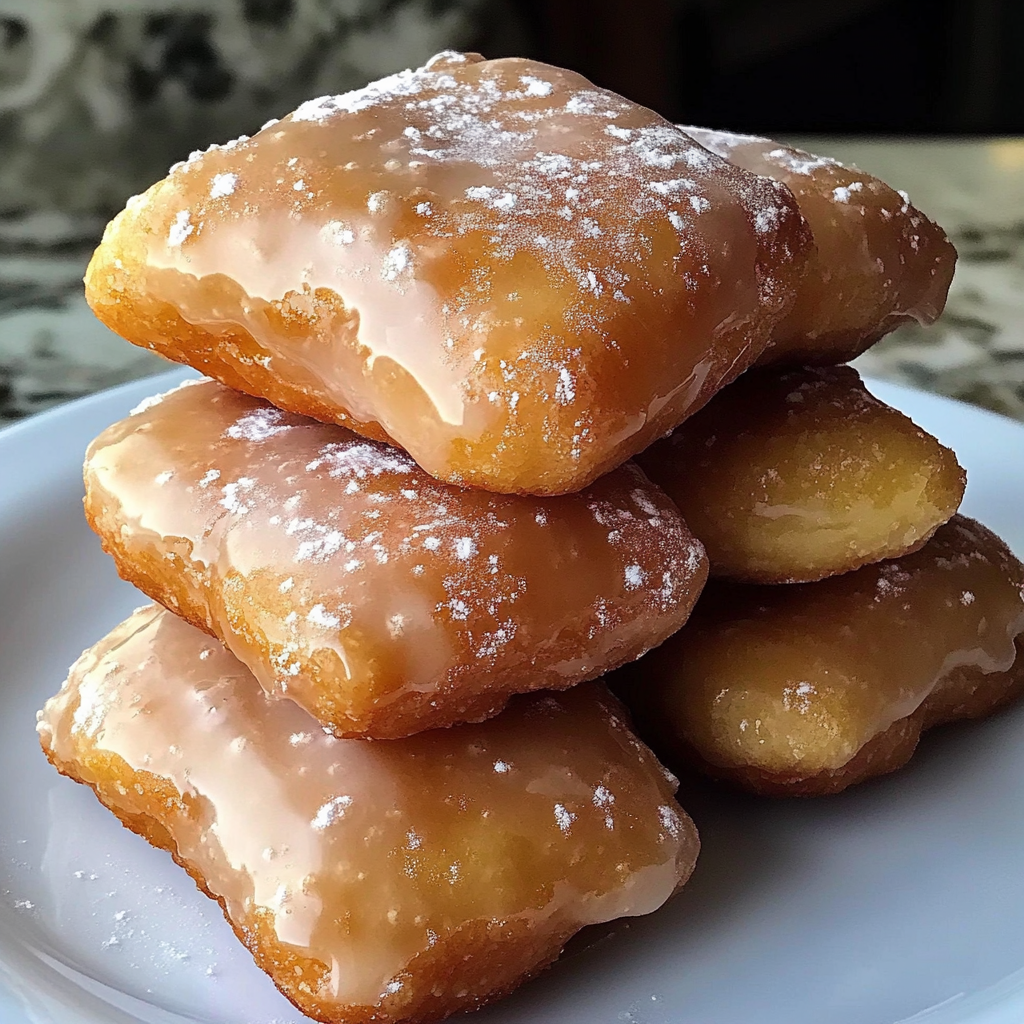🥐 Introduction to Glazed Buttermilk Beignets
Few things compare to the sweet satisfaction of biting into a warm, freshly fried glazed buttermilk beignet. These golden pillows of airy dough are crisp on the outside, fluffy inside, and coated in a silky vanilla glaze that elevates them from a simple pastry to an unforgettable indulgence. A delicious twist on the classic New Orleans beignets, this version swaps the traditional powdered sugar topping for a smooth, sweet glaze that melts perfectly over the hot dough.
What sets these beignets apart is the use of buttermilk in the dough. Its tangy richness not only adds depth of flavor but also creates an incredibly tender texture. When combined with a light yeast rise and carefully timed frying, the result is a pastry that’s both comforting and decadent.
Perfect for brunch, dessert, or a Mardi Gras celebration at home, glazed buttermilk beignets bring a taste of French-Creole heritage to your kitchen. And if you’re a fan of sweet breakfast creations like these, you might also enjoy our coconut cream pancakes for your next weekend treat.
In the sections ahead, we’ll dive into their origins, baking science, and a foolproof recipe to help you master this delightful treat.
Before diving in, it’s worth learning about the history of beignets in Louisiana—from their French roots to their rise as a Southern staple. Beignets were originally brought to Louisiana by French colonists and later popularized in the cafés of the French Quarter.
And if you’re new to deep frying or just want to up your game, this guide from Serious Eats on deep frying techniques is essential reading before you turn on the stove.
✨ What Are Glazed Buttermilk Beignets?
Beignets are deep-fried pieces of dough, typically square-shaped, soft on the inside, and slightly crisp on the outside. Traditionally topped with powdered sugar, this glazed version swaps the dusting for a sweet, smooth icing made with powdered sugar, milk, and vanilla.
The use of buttermilk adds a rich depth and light tang to the dough, helping it stay tender while also enhancing flavor complexity.
🥛 Why Buttermilk Makes a Difference
You might wonder: “Why not just use milk?” Here’s why buttermilk is worth the hype:
- Adds a tangy depth of flavor
- Activates baking soda for better rise
- Helps create a more tender crumb
- Balances sweetness with its slight acidity
Need a refresher on this versatile ingredient? Here’s a helpful guide to buttermilk benefits in baking that explains why it’s a baker’s best friend.
🧂 Key Ingredients You’ll Need For Glazed Buttermilk Beignets
Making truly irresistible glazed buttermilk beignets starts with the right ingredients. Each component plays a role in delivering the signature texture and flavor these fried pastries are known for.
- All-purpose flour: The perfect balance of protein to create a dough that’s soft yet sturdy enough for frying.
- Active dry yeast: Essential for that light, airy interior with just the right puff.
- Buttermilk: Adds tanginess and enhances tenderness while aiding in leavening.
- Egg: Helps enrich the dough and bind the ingredients.
- Melted butter: Brings in richness and softness.
- Sugar: Adds sweetness and promotes a golden crust during frying.
- Salt: Balances all the flavors.
- Powdered sugar, milk & vanilla extract: These make up the smooth vanilla glaze that defines this recipe.
Together, these ingredients create a beignet that’s crisp outside, tender inside, and coated with the perfect amount of glaze
🍯 Glaze vs Powdered Sugar: A Sweet Dilemma
When it comes to finishing your beignets, you’ve got options—but choosing between glaze and powdered sugar can shape the entire dessert experience.
Traditional New Orleans-style beignets are generously dusted with powdered sugar, offering a classic snowy look and a light sweetness. But swap that for a silky vanilla glaze, and you get a glossy finish that melts into the beignet, adding a richer, more indulgent bite.
Powdered sugar is delicate and nostalgic, while glaze delivers moisture, flavor depth, and a modern twist. If you’re torn, consider trying both—or even layering them for an extra treat.
🛠️ Equipment Checklist
Making perfect glazed buttermilk beignets doesn’t require a fancy kitchen, but having the right tools will make the process smoother and more enjoyable.
Here’s what you’ll need:
- Heavy-bottomed pot or deep fryer – for consistent frying temperature
- Candy or instant-read thermometer – ensures oil stays at optimal 350°F
- Mixing bowls – for combining wet and dry ingredients
- Rolling pin – to flatten the dough evenly
- Dough scraper or knife – for cutting those classic square shapes
- Slotted spoon or spider – to safely remove beignets from hot oil
- Wire rack + paper towels – for draining excess oil and setting the vanilla glaze
With these tools, you’re fully equipped to whip up bakery-worthy beignets right at home.

🧈 Choosing the Right Oil for Frying
The oil you use can make or break your glazed buttermilk beignets. To get that crispy golden exterior without any off-putting flavor, choose a neutral oil with a high smoke point.
Here are the best options:
- Canola oil – affordable, neutral, and widely available
- Vegetable oil – another great all-purpose choice
- Peanut oil – offers a slightly nutty flavor and excellent frying stability
Avoid oils like olive or coconut, which can burn quickly and alter the flavor profile. Keep your oil at a steady 350°F to ensure your beignets cook evenly and absorb minimal grease.
👨🍳 How to Make Glazed Buttermilk Beignets (Step-by-Step)
Ready to make a batch of fluffy, golden glazed buttermilk beignets at home? Follow this simple step-by-step guide to achieve bakery-quality results from your own kitchen.
📝 Ingredients
For the Dough:
- 3 ½ cups all-purpose flour
- 2 ¼ tsp active dry yeast
- ¾ cup warm water (about 110°F)
- ½ cup buttermilk
- 1 large egg
- 3 tbsp granulated sugar
- ¼ cup melted butter
- ½ tsp salt
For the Vanilla Glaze:
- 1 ½ cups powdered sugar
- 3–4 tbsp milk
- ½ tsp vanilla extract
🧑🍳 Instructions
1. Activate the Yeast
In a bowl, combine warm water and sugar. Sprinkle in the yeast and let it sit for 5–10 minutes until frothy.
2. Mix the Dough
In a separate bowl, whisk together buttermilk, egg, and melted butter. Add this to the yeast mixture. Gradually stir in flour and salt until a dough forms.
3. Knead and Proof
Knead on a floured surface for 5–7 minutes. Place in a greased bowl, cover, and let rise until doubled—about 1–2 hours.
4. Roll and Cut
Roll the dough to ½-inch thick. Cut into 2-inch squares using a dough cutter or knife.
5. Fry the Beignets
Heat oil to 350°F. Fry a few at a time for 1–2 minutes per side, until puffed and golden. Drain on a wire rack lined with paper towels.
6. Make the Glaze
Whisk together powdered sugar, milk, and vanilla until smooth.
7. Glaze and Serve
While still warm, dip each beignet in glaze. Place on rack and let set.
🌟 Tips for Light, Fluffy Beignets
- Don’t over-knead—just enough to bring it together.
- Let dough rise fully for optimal airiness.
- Fry in small batches to maintain oil temperature.
- Glaze while warm for best coating.

Glazed Buttermilk Beignets
- Total Time: 1 hour 30 minutes – 2 hours
- Yield: About 24 beignets 1x
- Diet: Vegetarian
Description
Light, fluffy, golden-fried glazed buttermilk beignets topped with a smooth vanilla glaze. These pillowy pastries are a sweet twist on the classic New Orleans treat.
Ingredients
For the Dough:
-
3 ½ cups all-purpose flour
-
2 ¼ tsp active dry yeast
-
¾ cup warm water (110°F)
-
½ cup buttermilk
-
1 large egg
-
3 tbsp sugar
-
¼ cup melted butter
-
½ tsp salt
-
Oil for frying (canola or vegetable)
For the Vanilla Glaze:
-
1 ½ cups powdered sugar
-
3–4 tbsp milk
-
½ tsp vanilla extract
Instructions
-
Activate Yeast: Combine warm water, sugar, and yeast. Let foam (5–10 mins).
-
Make Dough: Add buttermilk, egg, and melted butter. Mix in flour and salt until dough forms.
-
Knead & Rise: Knead 5–7 minutes. Cover and let rise 1–2 hours until doubled.
-
Cut & Shape: Roll dough to ½ inch and cut into 2-inch squares.
-
Fry: Heat oil to 350°F. Fry 1–2 minutes per side until golden. Drain on a rack.
-
Glaze: Whisk glaze ingredients. Dip beignets while warm. Let set on rack.
Notes
-
Substitute buttermilk by mixing ½ cup milk with 1½ tsp lemon juice or vinegar.
-
Do not overcrowd the fryer—work in small batches for even frying.
-
Let glaze set fully before stacking or serving.
-
Can dust with powdered sugar after glazing for extra sweetness.
- Prep Time: 15 minutes (plus 1–2 hours rise time)
- Cook Time: 15 minutes
- Category: Dessert / Breakfast
- Method: Frying
- Cuisine: French-American / Southern
Nutrition
- Calories: ~180 kcal
- Sugar: 9g
- Sodium: 90mg
- Fat: 8g
- Saturated Fat: 2.5g
- Carbohydrates: 23g
- Protein: 3g
- Cholesterol: 20mg
🍩 Variations to Try for Glazed Buttermilk Beignets
Want to jazz them up? Here are some ideas:
- Add lemon or orange zest to the glaze
- Toss dough with cinnamon or nutmeg
- Fill with pastry cream, jam, or Nutella before frying
- Dip in chocolate glaze instead of vanilla
🍽️ Serving Suggestions
- Serve with strong chicory coffee for a New Orleans café vibe.
- Add fresh fruit and whipped cream for a brunch board.
- Dust lightly with powdered sugar after glazing for extra texture.
🧊 Storage & Reheating Tips
Beignets are best fresh, but here’s how to extend their life:
- Store in airtight container at room temp for 1–2 days.
- Reheat in toaster oven for crispiness.
- Avoid microwaving—it makes them soggy!
- Not ideal for freezing once glazed.
🚫 Common Mistakes to Avoid
- Skipping the rise time—patience is key
- Overcrowding the fryer—causes uneven cooking
- Letting glaze set on paper towels—it’ll stick!
- Adding glaze while too hot—it’ll melt right off
FAQs About Glazed Buttermilk Beignets ❓
What’s the difference between a beignet and a doughnut?
Beignets are square, often yeast-based, and usually lighter and airier. Doughnuts are round and denser.
Can I make beignets without buttermilk?
Yes, but buttermilk enhances the flavor and texture. You can substitute with milk + lemon juice if needed.
How do I get my beignets fluffy?
Ensure your yeast is fresh, dough is properly risen, and oil is hot enough before frying.
Can I bake instead of fry?
Technically yes, but they won’t have the same crisp exterior or deep flavor.
Are beignets supposed to be hollow?
A bit of airiness is normal—they puff up when fried—but they shouldn’t be completely hollow.
How long do homemade beignets last?
They’re best eaten within 24 hours, though they can last up to 2 days in an airtight container.
🏁 Final Thoughts OF Glazed Buttermilk Beignets
Glazed Buttermilk Beignets bring a perfect blend of indulgence, comfort, and a touch of elegance. Whether you’re making them for a family brunch, a festive occasion, or just because you crave something golden and sweet, this guide has you covered.
With a little patience and some pantry staples, you’ll be amazed at how easy it is to create these melt-in-your-mouth treats at home. So roll up those sleeves, heat the oil, and get glazing—your weekend just got a whole lot better.



